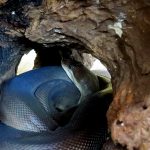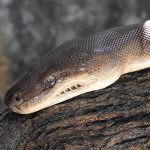OLIVE PYTHON
Olive Python
In the rugged terrains of northern Australia, a remarkable serpent glides through the underbrush—the Olive Python (Liasis olivaceus). This majestic creature, adorned in hues reminiscent of the Australian outback, embodies the spirit of the wild.
Physical Characteristics
Imagine a snake with a body that seems to shimmer under the sun, its scales smooth and lustrous. The Olive Python’s coloration ranges from deep olive-green to rich chocolate brown, with a creamy underbelly that contrasts beautifully. Adults typically measure between 2.5 to 4 meters in length, though some individuals have been recorded at lengths up to 6.5 meters.
Habitat and Distribution
This species is endemic to Australia, inhabiting regions from Western Australia through the Northern Territory to Queensland. They favor rocky areas, gorges, and woodlands, often near water sources. Sheltering in rock crevices, caves, and hollow logs, Olive Pythons are adept swimmers, frequently hunting in watercourses.
Diet and Hunting Behavior
As nocturnal ambush predators, Olive Pythons exhibit patience and precision. They prey on a diverse range of animals, including mammals like rock wallabies, birds, reptiles, and frogs. Employing a sit-and-wait strategy, they often remain motionless, awaiting the approach of prey. Once within striking distance, they seize their quarry, constricting it to ensure suffocation.
Reproduction
Mating occurs from May to mid-July, with females laying 12 to 40 eggs in late spring. These eggs incubate for approximately 50 days before hatchlings, measuring about 35 centimeters in length, emerge.
Conservation Status
The Olive Python is currently listed as “Least Concern” by the IUCN, indicating a stable population. However, they are protected under Australian wildlife regulations, and it’s illegal to harm or capture them without proper authorization.
Human Interaction
While generally non-aggressive, Olive Pythons can become defensive if threatened. It’s essential to exercise caution and respect their space. Misidentification with venomous species has led to unfortunate incidents, underscoring the importance of awareness and education.
The Olive Python stands as a testament to the resilience and beauty of Australia’s wildlife. Its presence in the ecosystem highlights the intricate balance of nature and the need for ongoing conservation efforts to preserve such magnificent creatures.


